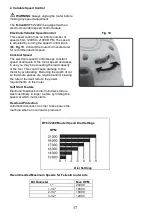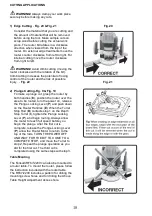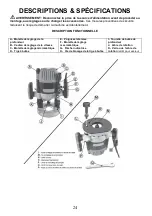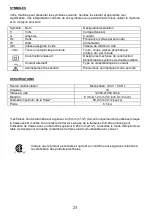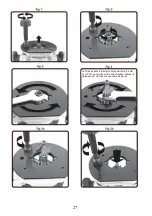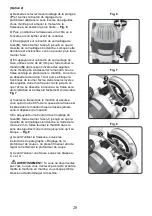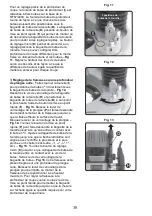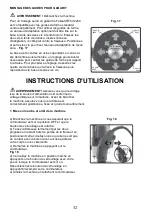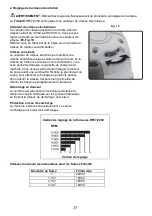
18
CUTTING APPLICATIONS
WARNING! Always clamp your work piece
securely before making any cuts.
1) Edge Cutting - Fig. 20 & Fig. 21
Consider the material that you are cutting and
the amount of material that will be removed
before using the tool. Make sample cuts on
scrap wood before cutting the actual work
piece. The router bit rotates in a clockwise
direction when viewed from the top of the
router. On external edge treatments move the
router counter clockwise from left to right. For
internal cutting move the router clockwise
from right to left.
WARNING! Avoid climb cutting (moving the
router clockwise with the rotation of the bit).
Climb cutting increases the potential of losing
control of the router and the risk of possible
injury. - Fig. 22
2) Plunge Cutting-Fig. 9 & Fig. 10
To make a plunge cut, grasp the router by
both handles (E), position the router over the
area to be routed, turn the power on, release
the Plunge Locking Lever (P) and push down
on the Router Handles (E). When the Turret
Stop Rod (D) contacts stop 1 on the Depth
Stop Turret (I), tighten the Plunge Locking
Lever (P), and begin routing. Always allow
the router to reach full speed before you
begin the plunge. After the first cut is
complete, release the Plunge Locking Lever
(P), allow the Router Motor to return to the
top of the rods, TURN THE POWER OFF
AND WAIT FOR THE BIT TO COME TO A
COMPLETE STOP, and move the Turret to
stop 2, Repeat the plunge operation as you
did for the first cut. The third cut is
completed using the same steps with stop 3.
Table Mouting
The Felisatti RF67/2200 can also be mounted to
a router table. To mount the router, please follow
the instruction included with the router table.
The RF67/2200 includes a pattern for drilling the
mounting screw holes and for drilling the Above
Table Height Adjustment Access hole.
Fig.20
Fig. 21














